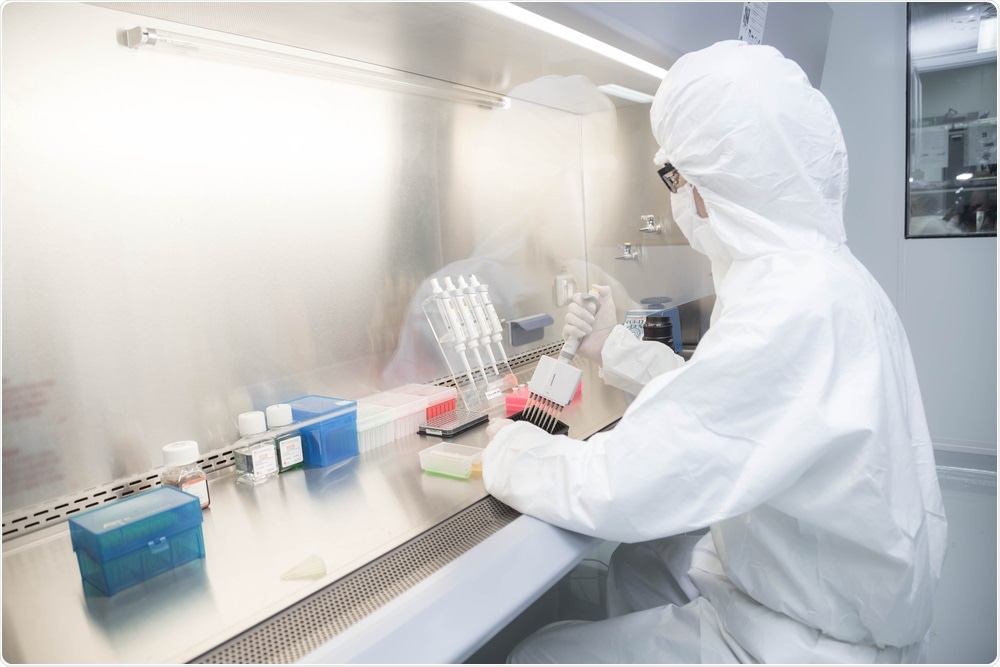A team in Massachusetts has established a method of profiling of mispairing in antibody assembly based on denaturing size-exclusion ultra-performance liquid chromatography (UPLC), alongside the process of intact protein mass spectrometry.

Image Credit: Tonhom1009/Shutterstock.com
Published this month in the journal Analytical Chemistry, the researchers describe how this method will be significant in enhancing the method of producing IgG-like multi-specific antibodies used in numerous research and therapeutic applications.
A new process for profiling mispairing
Recent years have seen a rapid increase in the use of immunoglobulin G-like (IgG-like) multi-specific antibodies in therapeutic applications.
These types of antibodies have demonstrated their use in therapies such as those using drugs to mimic the natural ligands in signaling pathways, treatments for hemophilia, where the drug treatments aim to simultaneously bind to the receptor pairs on the surface of a single cell.
Also, perhaps the most important application of these antibodies is within the treatment of cancer, where the tri-specific T-cell engager (TCE) is used to both activate the T-cells via CD3/CD28 receptor binding, as well as target the tumor antigen with fatal impact.
Essentially, IgG-like multi-specific antibodies have been found to offer great potential in the development of a number of therapeutic applications.
One major step in developing these antibodies successfully in the correct assembly of the subunits, which is considered to be a critical quality attribute (CQA).
Mispaired antibodies do not biologically perform in the way they are expected, and it is vital to spot these mispairings to ensure the quality of the antibodies produced.
This means that clone selection during cell lines that happens early on in drug development processes need to be informed of possible chain mispairing, allowing researchers to make decisions early on, enhancing risk mitigation.
Therefore, the Massachusetts-based team set out to establish a new high throughput analytical platform to reliably profile mispairing and other product-related impurities, as well as indicate half antibodies.
The research
The new method established by the team combined denaturing size-exclusion ultra-performance liquid chromatography (UPLC) with intact protein mass spectrometry to generate a high throughput analytical platform for profiling mispairing of antibodies, along with similar product-related impurities, such as half antibodies.
The team demonstrated that the method could reliably be performed on the clarified cell culture harvest fluid directly, with no requirement for Protein A purification nor other methods of sample preparation.
It was also shown that the method was successful at generating unbiased data regarding the quality of the clones, objectively determining the effect of the growth conditions.
Also, the platform showed itself to be a fast and cost-effective method of providing these results.
The Massachusetts-based researchers screened art quantities of clones that expressed tri-specific antibodies (tsAb) and demonstrated that while chain mispairing was mostly dependent on the antibody sequence, they also found it to be characteristic of the clone.
Finally, the team was able to show that the type and distribution of mispaired species impurities and half antibodies are influenced by different growth conditions. However, this may not impact the final quality of the clone.
Enhancing future drug development
Here, a platform was established for profiling mispairing and other product-related impurities in antibody assembly. Since these factors are associated with increased cost and decreased product yield in antibody production for therapeutic use, the platform will likely enhance this process and lead to higher quality antibody production.
Also, as the method was able to highlight the different growth conditions that may impact the type and distribution of the impurities, but not the clone quality, it confirmed that clone selection early on, based on mispairing data, is essential in drug development.
Journal references:
Kitazawa, T., Igawa, T., Sampei, Z., Muto, A., Kojima, T., Soeda, T., Yoshihashi, K., Okuyama-Nishida, Y., Saito, H., Tsunoda, H., Suzuki, T., Adachi, H., Miyazaki, T., Ishii, S., Kamata-Sakurai, M., Iida, T., Harada, A., Esaki, K., Funaki, M., Moriyama, C., Tanaka, E., Kikuchi, Y., Wakabayashi, T., Wada, M., Goto, M., Toyoda, T., Ueyama, A., Suzuki, S., Haraya, K., Tachibana, T., Kawabe, Y., Shima, M., Yoshioka, A. and Hattori, K. (2012). A bispecific antibody to factors IXa and X restores factor VIII hemostatic activity in a hemophilia A model. Nature Medicine, 18(10), pp.1570-1574. https://www.ncbi.nlm.nih.gov/pubmed/23023498
Krah, S., Sellmann, C., Rhiel, L., Schröter, C., Dickgiesser, S., Beck, J., Zielonka, S., Toleikis, L., Hock, B., Kolmar, H. and Becker, S. (2017). Engineering bispecific antibodies with defined chain pairing. New Biotechnology, 39, pp.167-173. https://www.ncbi.nlm.nih.gov/pubmed/28137467
Tousi, F., Jiang, Y., Sivendran, S., Song, Y., Elliott, S., Paiva, A., Lund, A., Albee, K. and Lee, K. (2020). Intact Protein Mass Spectrometry of Cell Culture Harvest Guides Cell Line Development for Trispecific Antibodies. Analytical Chemistry, 92(3), pp.2764-2769. https://www.ncbi.nlm.nih.gov/pubmed/31940175